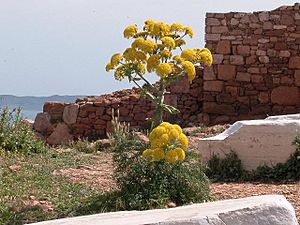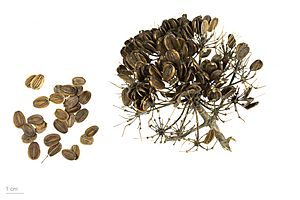Giant fennel facts for kids
Quick facts for kids Giant fennel |
|
|---|---|
 |
|
| Scientific classification | |
| Genus: |
Ferula
|
| Species: |
communis
|
The Giant Fennel, known scientifically as Ferula communis, is a tall flowering plant that belongs to the carrot family, Apiaceae. It is a relative of the more common Fennel (Foeniculum vulgare).
This plant is a tall herb that lives for many years, meaning it's a perennial plant. You can find Giant Fennel growing in warm, sunny places around the Mediterranean Sea and in East Africa. Long ago, in ancient times, people knew this plant by the names laser or narthex.
Giant Fennel and People
People have used Giant Fennel for a long time. Its young stems and flower clusters were eaten in ancient Rome, and some people in Morocco still eat them today. However, it's important to know that eating this plant can sometimes be unsafe and cause poisoning.
In a place called Sardinia, scientists have found two types of Giant Fennel. One type is poisonous, especially to animals like sheep, goats, cattle, and horses. The other type is not poisonous. These two types look similar but have different natural chemicals inside them.
The sticky sap, or resin, from a certain kind of Giant Fennel (called F. communis subsp. brevifolia) is known as “gum ammoniac of Morocco.”
A special chemical called ferulic acid is named after the Giant Fennel, because it can be taken from this plant.
In ancient Greek stories, the god Prometheus is said to have brought fire to humans by hiding it inside the hollow stalk of the Giant Fennel plant.
How Resin Was Collected
For thousands of years, the sticky resin from Ferula plants has been used as medicine. This resin, which looks like a thick liquid, was usually taken from the lower part of the stem or the root. The resin from the root was considered the best quality.
To collect the resin from Giant Fennel, people would first clear away any rocks or dirt around the root. Then, they would make a small hole in the root or lower stem using a sharp tool. A small ditch was dug under the root, and flat stones were placed at the bottom to catch the resin as it dripped out. The hole was made deep enough so the resin would flow out on its own.
The best time to collect the resin was during the dry, hot summer months, because moisture could spoil it. When the resin touched the air, it would get hard and turn a brownish-red color. The resin that came out in small, hard drops was thought to be better than the resin that just ran out loosely.
Used for Discipline
In the past, the strong, hollow stalks of the Giant Fennel were sometimes used to make rods or whips for disciplinary purposes, like in schools. This is where the Latin word ferire, meaning "to hit," comes from. It also relates to the Swedish word färla, which was a tool used for discipline in old schools.
See also
 In Spanish: Cañaheja para niños
In Spanish: Cañaheja para niños


